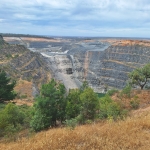US: Oil Industry, Lawmakers Aim To Lift Bans on Drilling
Fears Over Supply Drive Push to Enter
Protected U.S. Areas
Protected U.S. Areas
Mounting concerns about global energy supply are
fueling a drive by the oil industry and some U.S. lawmakers to end
longstanding bans on domestic drilling put in place to protect
environmentally sensitive areas.
Increasing U.S. oil production would require
overturning decades-old moratoriums that limit offshore drilling and
accelerating leasing of federal lands, moves that would trigger a swift
and vigorous political backlash. Still, as gasoline prices continue to
climb and squeeze household budgets, the momentum appears to be gaining
to open up new areas.
Oil prices have soared 36% this year, though the price
of a barrel of crude for July delivery settled at $130.81 on the Nymex
on Thursday, down 1.8% from its record close Wednesday.
"These prices are making voters realize we need to
produce [more] energy" domestically, said Rep. John Peterson, a
Republican from Pennsylvania who is pushing legislation to open up new
offshore areas for energy exploration. The U.S. imports two-thirds of
its oil, though less than one-sixth of its natural gas, according to
federal data. The rest is produced domestically.
A century and a half after oil production began, there
is ample evidence that a lot of oil -- and natural gas -- remains to be
found in the U.S. and its territorial waters. Some of those areas are
wide open to oil companies, including most of the Gulf of Mexico where
deep-water floating rigs now routinely drill wells hundreds of miles
from shore. Even in the gulf, areas are off limits, including most of
the waters off the Florida coast. The entire East and West Coasts are
off limits for new drilling.
Last week, Exxon Mobil
Corp. Chief Executive Rex Tillerson chided President Bush for asking
Saudi Arabia to boost its production, while not doing more to increase
production at home in the U.S., particularly off the coasts of Florida
and California.
"There is no question in my mind that there is
significant conventional resources available," Mr. Tillerson said in an
interview last week. "If you are looking for larger fields, they will
probably be found in the offshore areas that are currently off limits."
Those offshore areas are closed to exploration and
drilling under congressional moratoriums and presidential executive
orders that command broad support among elected officials in the
politically powerful states of California and Florida. Opening these
areas up could prove nettlesome.
Little data exist about how much oil and gas might be
found under the waters now closed for exploration. Federal agencies are
prevented from doing rudimentary geological surveys in most areas to
pinpoint areas of interest. The last time the industry shot seismic
imagery was in the 1970s when this widely used search technology was in
its infancy.
Other promising areas onshore also are off-limits. In
a report last week, the federal Bureau of Land Management stated that
at current U.S. consumption levels there are four years worth of oil
and 10 years worth of natural gas under federal lands. However, more
than 90% of that energy was under lands either closed to development or
open with significant environmental restrictions. The federal Minerals
Management Service said an additional three years worth of oil and gas
is in offshore areas where drilling isn't allowed.
"People have no idea what kind of resources might be
out here," said Duane Zavadil, vice president for government and
regulatory affairs for Rocky Mountains producer Bill Barrett Corp. He
said his company could double or triple its production growth if
regulatory hurdles were relaxed.
Critics of the land management bureau's report --
including some Democratic congressional leaders -- argue that it gives
a false impression that more drilling will lead to lower gasoline
prices. They note that drilling on federal lands has increased steadily
during the Bush administration, even as gas prices have risen.
"We simply cannot drill our way to lower prices at the
pump," Rep. Nick Rahall (D., W.Va.), chairman of the House Natural
Resources Committee, said in a written statement.
Environmental critics contend that new gas drilling in
the Rockies requires densely packed wells, turning natural vistas into
industrial landscapes. But others respond new horizontal wells allow
the industry to drill a cluster of wells in a single spot to drain a
large area, minimizing the area affected.
"It's undeniable the environmental impact is far less
now than it was 25 or 30 years ago. The footprint is something like
one-tenth what it used to be," said Kurt Gibson, deputy director of the
oil-and-gas division of Alaska's Department of Natural Resources.
Examples exist of environmental groups and the
industry finding middle ground to pave the way for exploration. In
April, a consortium of environmental groups agreed to drop opposition
to an oil development that would drill wells beneath waters off Santa
Barbara, Calif., in exchange for several concessions from the oil
company, including a promise to conclude production by 2023.
New drilling techniques also are driving production in
places such as North Dakota's Bakken field, which the federal
government estimated in 1995 held 150 million barrels. This year, an
updated assessment put the figure at 3.65 billion barrels, said Brenda
Pierce, coordinator of the U.S. Geological Survey's Energy Resources
Program. "We have the potential to grow production," she said. "We just
have to weigh it against all the consequences."
In Washington, Republican lawmakers and oil-industry
lobbyists are arguing that opening restricted areas would boost supply
and bring down oil prices. Critics contend not enough is being done to
encourage alternative fuels and development of already-leased federal
lands. Of the more than 45.5 million acres of federal land under lease,
oil companies aren't producing oil or gas on 31 million acres.
"Why would we expect oil and gas companies to rush
these new areas into production, when they are sitting on literally
millions and millions of acres of existing leases without carrying out
any production on them?" said Sen. Jeff Bingaman (D., N.M.).
This snail's pace is leading some to try to wrest back
existing leases. Alaskan officials are locked in a legal battle with
Exxon, BP PLC and Chevron
Corp. to reclaim leases on a North Slope oil-and-gas field that is
estimated to hold eight trillion cubic feet of natural gas and hundreds
of millions of barrels of oil. The companies acquired the leases
decades ago but have yet to produce oil or gas. Exxon, which holds the
largest interest in the field, has said in the past that it hasn't
drilled because there is no pipeline to move the gas to market.
Write to Stephen Power at stephen.power@wsj.com
- 107 Energy
- 183 Environment



